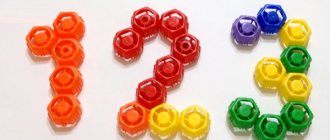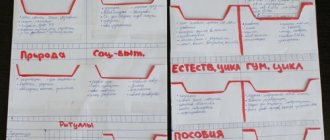Progress of the game:
Option 1: Children are given pyramids with caps. The teacher disassembles his pyramid and invites the children to do the same. Then he draws attention to the holes in the rings and shows how to put them on the rod. Children act by imitation: with one hand they hold the base of the pyramid, with the other (leading)
take the rings. The rings are strung in any order. If there are difficulties, the teacher helps using joint actions and a pointing gesture. When repeating the game, the position of the hands changes: the child holds the rod with the leading hand, and strings the rings with the other.
Option 2: Children are given two pyramids: one with a thick core and the other with a thin core. The rings of both pyramids are removed and mixed. Children must match the holes correctly to the correct rod. The teacher teaches how to make a choice by trial, each time correlating the size of the hole with the thickness of the rod.
Option 3: The material changes. Children are offered pyramids with compound rings of different sizes.
COLORFUL WORLD
didactic color perception game
Target:
• Develop a positive attitude towards the game and teach how to focus on color in the game as a significant feature.
• Learn to distinguish colors, focusing on their uniformity or heterogeneity when applied.
• Learn to denote the result with the words “such”
,
“not like that”
, teach to act by imitation.
• Learn to select the same colors by eye and then check.
Equipment:
Thick sheets of paper depict ornaments consisting of circles of different colors; colored plastic covers that match the colors of the ornament.
Progress of the game:
The teacher places one of the ornaments and a set of colored caps in front of himself and the child, paying attention to their similarity. Then he explains how to assemble the ornament so that it turns out to be a beautiful design. At the same time, the teacher says: “I take the red cap, put it on the red circle.”
.
The child can independently try to assemble the ornament, placing a lid on the circle, saying: “I took this one,”
or after trying it on,
“I took it not like that
. During the game, the teacher must praise the child for choosing the right color.





